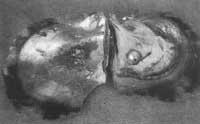The most beautiful pearl
1992/06/01 Elhuyar Zientzia Iturria: Elhuyar aldizkaria
Researchers try to make living organisms produce inorganic materials. It is about obtaining synthetic ceramics and particles harder than microscopic magnets so that one day they can be used in small machines.
The synthesis of organically produced materials is carried out through a process called "biomimetic", which is not difficult at all. Last March, Mehmet Sarikaya, a researcher at the University of Washington, expressed at a conference in Indianapolis his intention to copy the production techniques proper to the organisms, thus avoiding the high temperatures and pressures required by synthetic methods.
Sarikaya wants to get the nakare. Mother-of-pearl is found inside the marine ears, nautilus and bivalve shells and is harder than any synthetic ceramic.

Sarikaya has been limited to the marine ear for research. Its shell is cemented calcium carbonate mixed with organic matter. The outer part of the shell consists of hexagonal calcium carbonate prisms. Inside is a layer of nacarado with calcium carbonate plates.
The marine ear contains cells to produce mother-of-pearl. These cells release protein to marine waters between shells. The water contains calcium and carbonate ions, which through an unknown process bind and cement the ions forming a layer of mother-of-pearl.
Sarikaya has managed to isolate the mother-of-pearl protein and is now in the identification phase.
Once the identification is done, you must find the necessary gene for the production of the protein and, subsequently, by genetic engineering, the gene will be injected into the bacteria Escherichia coli. This bacteria will produce a lot of protein.
Sarikaya hopes to use his method to cover different objects. This will introduce the objects into a solution with ions and proteins. However, being in the first phase of research, it has indicated that it will take five more years to complete the process.

Gai honi buruzko eduki gehiago
Elhuyarrek garatutako teknologia



